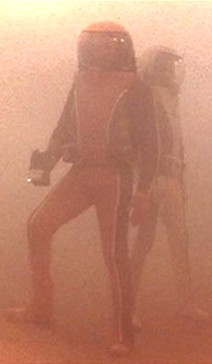EV Suit
An environmental suit, also known as an EV Suit, is a special form of clothing designed to be used for protection or life support in inhospitable environments.
With the advent of space travel came the need to perform tasks outside the controlled atmosphere of the space vessels. For this purpose, the EV suit was developed. As planets and other stellar objects came within the reach of Human space explorers, the EV suit became a necessity for exploring environments with different atmospheric conditions than those on Earth.
History[edit]
During the launch of the Phoenix in 2063, the use of space suits seemed optional. Zefram Cochrane and his copilots did not wear any pressure or flight suits. He made history by making First Contact with an alien species after the Phoenix had ended its flight. (Star Trek: First Contact)
22nd Century[edit]
In the middle of the 22nd century, Starfleet tested the new warp five engine in the NX program. The test pilots of the NX-Alpha and NX-Beta starships used only unpressurized flight suits.
A new NX-class EV suit was introduced as standard issue on the Enterprise NX-01, the first ship of the new NX class. These suits were a dark gold-brown color with grey padding, and were comprised of several components.
Helmet[edit]
The design of the helmet allowed an almost normal field of view to the wearer. Though the vertical field of view was limited to eight degrees, the amount of room inside the helmet allowed the wearer to compensate by simply moving his or her head. The helmet had a clear visor integrated into the front that could not be opened separately. It featured two outside lights, one on either side, and two ambient lights inside to illuminate the wearer's face. When the helmet was sealed, the ambient lights would activate. A small earphone was attached to the helmet which the wearer could insert in his or her ear, making it possible to stay in contact with a ship or other space vehicle.
Located on the back of the helmet were the air hoses to the oxygen supply and an electrical connector for the light, communication, and propulsion units. The helmet connected to the life support and propulsion unit via a secondary connection ring and not to the EV suit directly. Padding within the helmet made sure the wearer could not touch the visor with his or her face.
EV Suit[edit]
The EV suit was made as one full piece that closed at the front via a zip fastener and ended just below the elbow. The suit was self-sealing, meaning that if it were punctured or damaged in some way, sealant would be automatically applied to prevent the suit from decompressing. Although the suit was solid enough to protect its wearer from the rigors of space, a hypospray could still penetrate it in case of an emergency. Even with the heavy padding and protection, the suit could only protect its wearer against a neutronic wavefront for about 22 minutes.
Life Support and Propulsion[edit]
The life support and propulsion unit (or "LSPU") consisted of a hard upper torso body-shell and a harness. This unit contained the essentials for survival in space: communication equipment, oxygen, propulsion unit, EV controls, and the power supply. It was padded to give the wearer some extra comfort. The LSPU also held an extra oxygen hose for refilling or sharing the oxygen supply. This extra hose allowed oxygen to be replenished from any device that held liquid oxygen, provided the physical connection would fit.
On the front of the unit, the following switches were present: communications, oxygen transfer, lighting and propulsion activation.
On the back were the incoming and outgoing oxygen connections. These hoses were fastened via a bayonet joint to prevent accidental release. Below one of the oxygen connections was an air supply indicator, divided into eight equal parts. This indicated the level of oxygen by means of color coding – green, yellow and red. In 2154, this air supply indicator was removed and replaced by an analog indicator on the right side of the LSPU. The back of the unit also contained an electrical cord, which transferred power and communications from the LSPU to the electrical connector at the back of the helmet.
The harness consisted of two leg bands that were connected to each other via a belt that was also used to hold small tools as necessary. The LSPU was secured to the harness at four attachment points to keep the unit in place.
Gloves[edit]
The gloves had five digits and were connected to the EV suit via a zip fastener just below the elbow. They were also self-sealing.
Boots[edit]
The boots were made out of the same material as the EV suit and could be magnetized. (ENT: "Minefield", "Babel One")
Starship Use[edit]
On the NX class starships, at least six EV suits were present. Senior officers and some security personnel had their own suits, while the rest of the suits were shared for general use. (ENT: "The Catwalk", "The Crossing")
23rd Century[edit]
During the 23rd century, the EV suit had considerably advanced from the primitive suits of the century before. There were different types of suits for different environments, but only one of them was standard issue for Federation starships and various Federation facilities like the Elba II Asylum. These EV suit were significantly more flexible than their predecessors before and less bulky. Late in the 23rd century, the standard issue EV suit changed dramatically.
Helmet[edit]
The helmets of the standard-issue EV suits were taller and more spacious, yet still smaller than their 22nd century counterpart. The clear, unopenable visor was much more vast and took up a majority of the helmet. It stretched from the front of the helmet, all the way to the back. A strange ambiguous light emanated from the bottom of the helmet and upward for the occupant to see. Late in the 23rd century, the helmets became more domed with the visor facing forward. These helmets were also spacious and allowed a lot of head room.
EV Suit[edit]
The EV Suit was a chromo-metallic and form-fitting one-piece suit with a white belt that fastened around the waist. A phaser could be either holstered or attached to the white belt, depending on the severity of the away mission. The helmet was detachable and the name tag of the occupant could be seen on it. The upper chest and neck area of the suit had a built-in communicator. Late in the 23rd century, the EV suit generally remained the same except the color varied.
Life Support and Propulsion[edit]
All life support and propulsion systems were interwoven together as part of the EV suit in order to function better in hostile environments. Later in the 23rd century, propulsion relied upon a jet propulsion pack that was placed on the back of the EV suit. The jet propulsion pack was detachable.
Gloves[edit]
The gloves had five digits and were connected to the EV suit. They were detachable and fastened just below the elbow.
Boots[edit]
Each EV suit came with magnetic boots made out of the same material as the EV suit.
24th Century[edit]
By the 24th century, the EV suit had changed into a white tight-fitting suit. Some pieces of the suit were gender-specific, allowing a more customized fit than some of the previous suits.
Helmet[edit]
The helmet was smaller than its 22nd century counterpart but retained the clear and unopenable visor. Inside, two ambient lights were present on each side of the helmet to illuminate the wearer's face. Audio equipment, like a microphone and speaker, were integrated.
EV Suit[edit]
The EV suit was made as one part and was not self-sealing.
Life Support[edit]
The life support unit consisted of a hard upper-torso body-shell, which was different for men and women. This unit contained the essentials for survival: communication equipment, oxygen, EV controls, power supply, and again an extra oxygen hose that made it possible to share oxygen. Alerts were available visibly via the color-coded EV controls and also by audio.
Under normal conditions, an EV suit will be able to provide approximately 24 hours of oxygen. (VOY: "Day of Honor")
Gloves[edit]
The gloves had five digits and were connected to the EV suit via a self-sealing mechanism.
Boots[edit]
The boots were made out of the same material as the EV suit and could be magnetized.
Back-up System[edit]
Tom Paris and Harry Kim were kept alive by the backup system of their environmental suits, by "keeping their vital functions going" while unconscious. The system kicked in due to an environmental seal in their suits had been compromised, depleting the oxygen. (VOY: "Demon")


